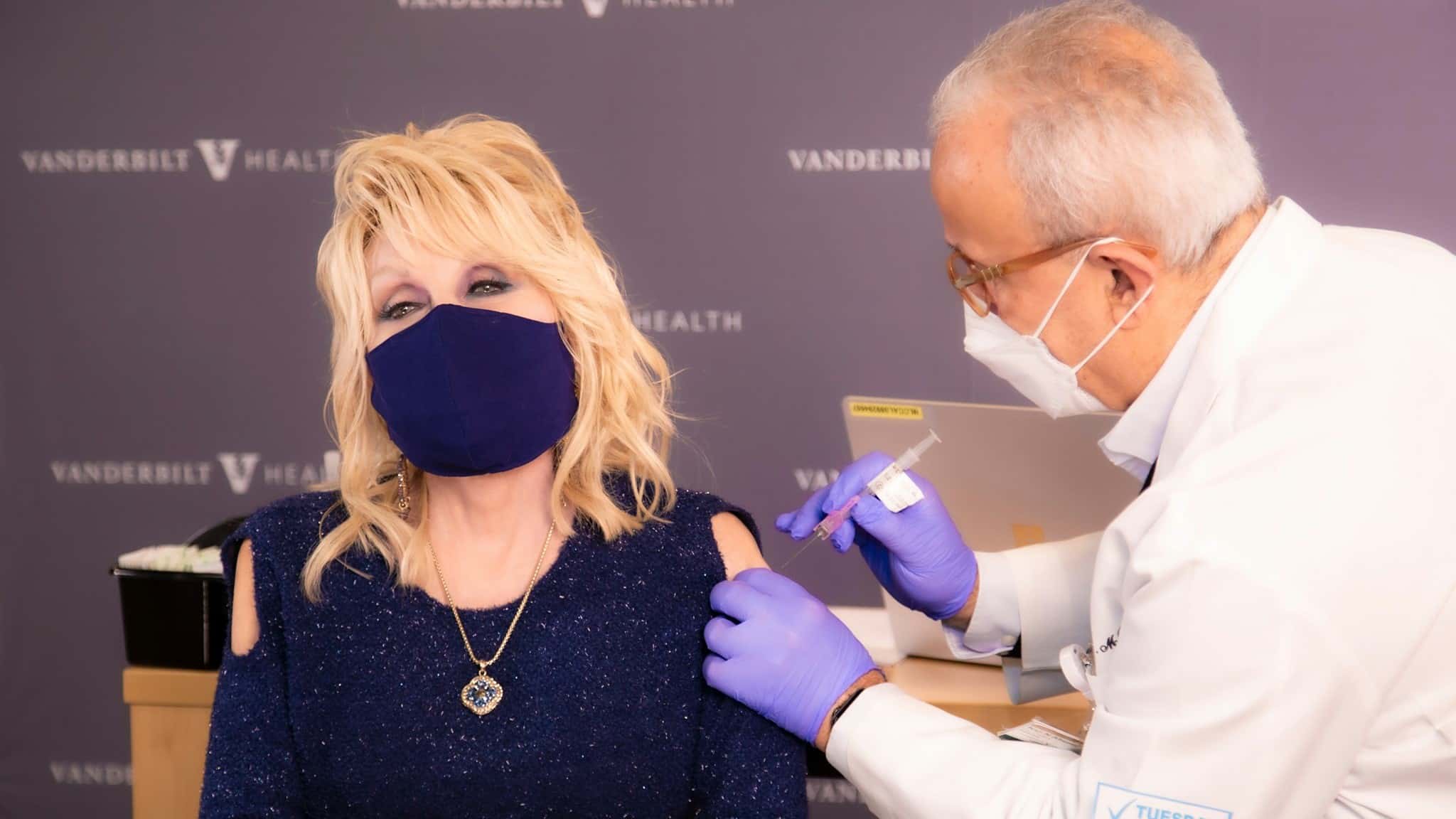Aaron Carroll’s job is to persuade Americans to get their COVID-19 shot. His technique? To listen and provide solid information.

American singer Dolly Parton receives a dose of the COVID-19 vaccine whose research she helped fund, Nashville, Tennessee, 2 March 2021. (From Parton’s Facebook page)
U.S. President Joe Biden dangled in-person barbecues on July 4. Pope Francis described it as a moral obligation. Dolly Parton funded vaccine research to the tune of $1 million.
But Aaron Carroll persuades Americans to get their COVID-19 shot one webinar, one phone call, one person at a time.
“It’s hard to change people’s minds,” said Carroll, a medical school pediatrics professor whose work managing the coronavirus at Indiana University (IU) — where the author teaches journalism — prompted his recent appointment as IU’s inaugural chief health officer. “People want to be heard. Being heard takes time, and it takes effort.”
Vaccines are widely available in the United States, but by June 21, just over 45% of Americans were fully vaccinated, or 150 million people.
This was despite the fact that, overall in 2020, in terms of total estimated “life years” lost, COVID-19 had a greater impact than all accidents combined and was three times as damaging as liver disease or diabetes.
‘Talk like a human being, avoid jargon and practice patience.’
As anyone knows who has vaped, cycled without a helmet or jumped out of a plane, the risk of premature death does not always change behavior. It’s hard to measure how reluctant people are to get vaccinated, but the U.S. Centers for Disease Control and Prevention recently estimated that up to about one in four individuals are vaccine-hesitant, depending on the county.
In Indiana, that figure was 11% in Monroe County, which includes the college town of Bloomington, home to IU’s main campus.
“Part of the problem is that people are hesitant for a variety of reasons, and overcoming that requires detailed, retail work understanding what the individual’s hesitancy is in order to overcome it,” Carroll said in an interview. “We want to believe that there’s a magic switch, that there’s one thing we can do — and we’d like it to be easy and quick. That is rarely true.”
For Carroll, this has meant dozens of “Ask Aaron” webinars and hour-long phone calls. He’s talked to leaders in business, community and church groups, students, athletes and even legislators, hoping that if he gives them the right data, they will persuade others.
“It’s not like I’m going in with my main goal is that I need to make you agree with me,” he said. “My main goal is I need to give you good information to make sure that you’re not listening to misinformation or disinformation, so that everybody can make the best choices for themselves and for the community.”
His approach is to talk like a human being, avoid scientific jargon and practice patience.
“We have done, I would say, 60 webinars over the course of this year,” he said. “Other people would lose their minds, and I’m like, ‘No-no-no-no-no, this is the work.’
“And people say, ‘But you’re answering the same questions over and over again,’ and I say ‘Yes, yes, because you need repeated messages.’ I in no way believe that just because I said something once, that everyone has heard it and now agrees with me.”
Getting used to people disagreeing
In Bloomington, a town of about 85,000 people, about half of them students, the complexities of messaging came to the fore in May, when partially state-funded IU announced it would require all students and employees to be vaccinated.
Then Todd Rokita, the state attorney general, ruled IU could not require proof of vaccination because of a state law that banned “immunization passports” for government entities, although, crucially, not in schools.
Although the vaccine is still a requirement, people can “attest” to having been vaccinated or face regular testing. However, on Monday, a group of students filed a federal lawsuit challenging what the law firm representing them called a “draconian COVID Vaccine Mandate.”
Faced with the likelihood of a surge of infections among the unvaccinated this fall, such objections will likely mean more phone calls for Carroll. “I have just gotten very used to people disagreeing. I’m comfortable with it. I don’t always love it, but it does not rankle me in the way it does with others.”
However, high levels of vaccination have always required mandates, usually in schools, and the smaller the number of unvaccinated, the harder the work will get. “Smallpox? Mandated. That’s why it’s gone. Polio? Mandated. That’s why it’s gone.”
For Americans, COVID-19 has become politicized.
For Jessica Myrick, a professor of Media Studies at Pennsylvania State University whose work includes studying the role of emotions in preventative health communication, COVID-19 is complicated because it has become so politicized, and institutions are desperate to find the right messaging because they depend on people performing a public health behavior.
“From a health communications standpoint,” Myrick said in an interview, “it’s a perfect storm.”
Scholars like Myrick — who previously worked at IU — understand this work in part by using something called prospect theory. Psychologist and economist Daniel Kahneman shared the 2002 Nobel Memorial Prize in Economic Sciences partly for his role in developing the framework.
Myrick noted that a lot of institutions are focused on the pain and suffering people will experience if they fail to get vaccinated. “What they are using is called a loss frame,” she said. “They are emphasizing the cost rather than the benefit.”
But this approach won’t necessarily work. “If you look at all of the research that studies loss frames, they are typically not more effective than any other type of message, so it’s a risky strategy.”
Removing barriers to getting vaccinated
Communicators are caught in a bind: a light-hearted approach could be seen as inappropriate with such a serious pandemic. “The risk is that people feel like you are impeding on their freedom to make decisions, and they tend to react negatively and don’t do the behavior out of spite.”
And people who have withstood the offer of vaccination for so long may be wedded to their resistance as part of their identity. “I think one of the underexplored potential ways for this type of messaging to backfire is that it emphasizes shame, as in, ‘You are a bad person if you don’t get the vaccine.’”
While legislation is helpful, she said, removing barriers is also crucial. Examples include large vaccination clinics like those IU has run on campus and online and telephonic vaccination registration systems run by the state.
Like Carroll, Myrick noted the language institutions deploy needs to fit into a larger, structural effort.
“As a communications scholar, it might seem radical to say this,” she said, “but I don’t think we can depend on communications alone, at this point, to move people who haven’t yet gotten a vaccine.”
Questions to consider:
- Country singer Dolly Parton helped fund the vaccination she received in an effort to encourage others to do the same. What famous person might persuade you to do something you’re afraid to do?
- How prevalent are vaccines where you live? What is being done to encourage people to get vaccinated? Have you found yourself having to persuade family members or others to get vaccinated?
- Some scholars see the COVID-19 vaccine marketing challenge as an opportunity to test prospect theory, which is referred to in the article. What strategy do you think would be most likely to persuade you? How about someone you know who is older? Or someone you know who is vaccine-hesitant?

Elaine Monaghan has worked for two decades in international journalism. For Reuters, she was a correspondent in Russia; chief correspondent in Ukraine and Belarus, and in Ireland and Northern Ireland; and U.S. State Department correspondent in Washington. She joined The Times in 2002 as Washington correspondent before moving to the Congressional Quarterly. Currently she is professor of practice at Indiana University’s Media School and serves as a freelance editor for Reuters.
